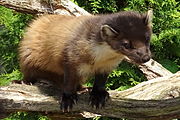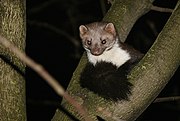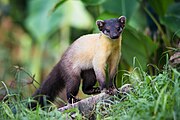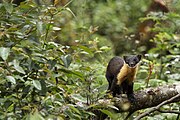Superregnum: Eukaryota
Cladus: Unikonta
Cladus: Opisthokonta
Cladus: Holozoa
Regnum: Animalia
Subregnum: Eumetazoa
Cladus: Bilateria
Cladus: Nephrozoa
Superphylum: Deuterostomia
Phylum: Chordata
Subphylum: Vertebrata
Infraphylum: Gnathostomata
Megaclassis: Osteichthyes
Cladus: Sarcopterygii
Cladus: Rhipidistia
Cladus: Tetrapodomorpha
Cladus: Eotetrapodiformes
Cladus: Elpistostegalia
Superclassis: Tetrapoda
Cladus: Reptiliomorpha
Cladus: Amniota
Cladus: Synapsida
Cladus: Eupelycosauria
Cladus: Sphenacodontia
Cladus: Sphenacodontoidea
Cladus: Therapsida
Cladus: Theriodontia
Cladus: Cynodontia
Cladus: Eucynodontia
Cladus: Probainognathia
Cladus: Prozostrodontia
Cladus: Mammaliaformes
Classis: Mammalia
Subclassis: Trechnotheria
Infraclassis: Zatheria
Supercohors: Theria
Cohors: Eutheria
Infraclassis: Placentalia
Cladus: Boreoeutheria
Superordo: Laurasiatheria
Cladus: Scrotifera
Cladus: Ferungulata
Cladus: Ferae
Cladus: Pancarnivora
Cladus: Carnivoramorpha
Cladus: Carnivoraformes
Ordo: Carnivora
Subordo: Caniformia
Infraordo: Arctoidea
Superfamilia: Musteloidea
Familia: Mustelidae
Subfamilia: Mustelinae
Genus: Martes
Species: M. americana - M. flavigula - M. foina - M. gwatkinsii - M. martes - M. melampus - M. pennanti - M. zibellina– †M. ten
Name
Martes Garsault, 1764: pl. 719
Type species: Martes domestica Pinel, 1792 (= Mustela foina Erxleben, 1777).
Synonyms
Charronia Gray, 1865
Foiana Gray, 1865
Lamprogale Ognev, 1928
Mustela Blasius, 1857
Pekania Gray, 1865
Zibellina Kaup, 1829
References
Primary references
Garsault, F.A.P. de 1764. Les figures des plantes et animaux d'usage en médecine, décrits dans la Matière Médicale de Mr. Geoffroy Médecin, dessinés d'après nature. Gravés par Mrs. Defehrt, Prevost, Duflos, Martinet &c. Niquet scrip. Vol. 5. pl. 644–729. Paris: Desprez. BHL. Reference page.
Ognev, S.I. (Огнев, С.И.) 1928. Новые данные по систематике и географическому распространению некоторых видов семейства Mustelidae [New data on the systematic and the geographical distribution of some species of the family of Mustelidae]. Мемуары Зоологического отделения Общества любителей естествознания, антропологии и этнографии 2: 1–31. – Москва: [Общество любителей естествознания при 1-м МГУ]. 25x17 см. (Russian) Reference page.
Additional references
Pinel, P. 1792. Recherches sur une nouvelle méthode de classification des quadrupèdes, fondée sur la structure méchanique des parties osseuses qui servent à l'articulation de la mâchoire inférieure. Actes de la Société d'Histoire Naturelle de Paris 1: 50–60. BHL Reference page. [see p. 55] [subsequent use]
Links
Taxon identifiers
Wikidata: Q26533 ADW: Martes BOLD: 3993 EoL: 34549 EPPO: 1MRTSG Fauna Europaea: 305306 Fauna Europaea (2): 92b4d7bc-c293-47af-a4e9-ad0cfb6422c7 Fossilworks: 41126 GBIF: 2433765 iNaturalist: 41790 MSW: 14001203 NBN: NBNSYS0000134898 NCBI: 9658 uBio: 4232742
Vernacular names
беларуская: Куніцы
Deutsch: Echte Marder
Ελληνικά: Κουνάβι
English: Martens
Esperanto: Mustelo
español: Martes
eesti: Nugis
suomi: Näädät
Nordfriisk: Echt elken
日本語: テン
ไทย: หมาไม้
Türkçe: Sansar
A marten is a weasel-like mammal in the genus Martes within the subfamily Guloninae, in the family Mustelidae. They have bushy tails and large paws with partially retractile claws. The fur varies from yellowish to dark brown, depending on the species; it is valued by animal trappers for the fur trade. Martens are slender, agile animals, which are adapted to living in the taiga, and inhabit coniferous and northern deciduous forests across the Northern Hemisphere.
Classification
Results of DNA research indicate that the genus Martes is paraphyletic, with some studies placing Martes americana outside the genus and allying it with Eira and Gulo, to form a new New World clade.[2][3] The genus first evolved up to seven million years ago during the Miocene epoch.
| Common name | Scientific name and subspecies | Range | Size and ecology | IUCN status and estimated population |
|---|---|---|---|---|
| American marten
|
Martes americana (Turton, 1806)
Seven subspecies
|
Arctic Alaska east to Newfoundland, south to New York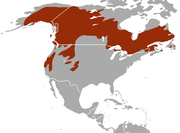 |
Size: Habitat: Diet: |
LC |
| Pacific marten
|
Martes caurina (Merriam, 1890)
Six subspecies
|
Southeast Alaska to central California, east to northern New Mexico | Size: Habitat: Diet: |
LC |
|---|
| European pine marten
|
Martes martes (Linnaeus, 1758) |
Europe and SW Asia, from Ireland in the west, eastward to the Urals and into Anatolia, Transcaucasia, Mesopotamia and northern Iran |
Size: Habitat: Diet: |
LC
|
|---|---|---|---|---|
| Beech marten
|
Martes foina (Erxleben, 1777)
Eleven subspecies
|
Spain and Portugal in the west, through Central and Southern Europe, the Middle East and Central Asia, extending as far east as the Altai and Tien Shan mountains and northwest China |
Size: Habitat: Diet: |
LC |
| Yellow-throated marten
|
Martes flavigula Boddaert, 1785
Three subspecies
|
Afghanistan and Pakistan, in the Himalayas of India, Nepal and Bhutan, the Korean Peninsula, southern China, Taiwan and eastern Russia |
Size: Habitat: Diet: |
LC |
|---|
| Nilgiri marten
|
Martes gwatkinsii (Horsfield, 1851) |
Southern India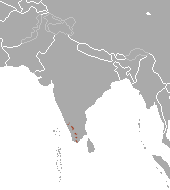 |
Size: Habitat: Diet: |
VU
|
|---|---|---|---|---|
| Sable
|
Martes zibellina (Linnaeus, 1758) |
Russia, Eastern Kazakhstan, China, North Korea and Hokkaidō, Japan |
Size: Habitat: Diet: |
LC
|
| Japanese marten
|
Martes melampus (Wagner, 1841)
Two subspecies
|
Japan |
Size: Habitat: Diet: |
LC |
Fossils
Several fossil martens have been described, including:
†Martes campestris (Pliocene)
†Martes wenzensis (Pliocene)[4]
†Martes vetus (Pleistocene)[5]
Another described fossil species, Martes nobilis from the Holocene, is now considered synonymous with the American marten.[6]
Etymology
The Modern English "marten" comes from the Middle English martryn, in turn borrowed from the Anglo-French martrine and Old French martre, itself from a Germanic source; cf. Old English mearþ, Old Norse mörðr, and Old High German and Yiddish מאַרדאַר mardar.
marten (n.)
agile, short-legged, bushy-tailed, medium-sized carnivorous mammal in the weasel family, largely nocturnal and found in forests across the colder parts of the northern hemisphere, c. 1300, martrin, "skin or fur of the marten," from Old French martrine "marten fur," noun use of fem. adjective martrin "of or pertaining to the marten," from martre "marten," from Frankish *martar or some other Germanic source, from Proto-Germanic *marthuz (source also of Old Saxon marthrin "of or pertaining to the marten," Old Frisian merth, Middle Dutch maerter, Dutch marter, Old High German mardar, German Marder, Old English mearþ, Old Norse mörðr "marten").
The ultimate etymology is unknown. Some suggest it is from PIE *martu- "bride," on some fancied resemblance. Or it might be a substrate word or a Germanic euphemism for the real name of the animal, which might have been taboo. In Middle English the animal itself typically was called marter, directly from Old French martre, but martrin took over this sense in English after c. 1400. The form marten is from late 16c., perhaps due to association with the masc. proper name Martin.[7]
Ecology and behaviour
Martens are solitary animals, meeting only to breed in late spring or early summer. Litters of up to five blind and nearly hairless kits are born in early spring. They are weaned after around two months, and leave the mother to fend for themselves at about three to four months of age.[8] They are omnivorous.[9]
Spatial niche segregation
It can be seen that there is a spatial niche segregation between certain species of marten such as the stone marten and the pine marten, however, we cannot credit this segregation to competition between the two species. It is more so due to the disparities in the two species' food preferences, avoidance of heavy predator pressure, and adaptability to cold climates that the spatial niche segregation occurs.[10]
Cultural references
Canada
The marten is populous in the northern Ontario community of Big Trout Lake. During the fur trade, commissioned by the Hudson Bay Company in the 18th and 19th centuries, the marten pelt was typically fashioned into mittens. The marten is still traded locally. The locals place a high value on this pelt, typically trading it for consumable goods.[citation needed]
Croatia
In the Middle Ages, marten pelts were highly valued goods used as a form of payment in Slavonia, the Croatian Littoral, and Dalmatia. The marturina was a form of tax named after this.[11] The banovac, a coin struck and used between 1235 and 1384, included the image of a marten. This is one of the reasons why the Croatian word for marten, kuna, was the name of the former Croatian currency.[12] A marten is depicted on the obverse of the 1-, 2-, and 5-kuna coins, minted since 1993, and on the reverse of the 25-kuna commemorative coins.[13] With adoption of euro as the national currency in 2023, a marten continues to be depicted on the obverse of the Croatian 1 euro coin.[14]
A running marten is shown on the coat of arms of Slavonia and subsequently on the modern design of the coat of arms of Croatia. The official seal of the Croatian Parliament from 1497 until the late 18th century had a similar design.[15][16]
Finland
The Finnish communications company Nokia derives its name, via the river Nokianvirta, from a type of marten locally known as the nokia.[17]
Greece
In the Illiad, the fleet-footed spy Dolon wore a marten-pelt cap.
Italy
The Latin word for helmet, galea, originally meant "marten pelt", although it is unclear whether early Romans wore these helmets for symbolical reasons or for their fine fur.[18]
References
Wilson, D. E.; Reeder, D. M., eds. (2005). Mammal Species of the World: A Taxonomic and Geographic Reference (3rd ed.). Johns Hopkins University Press. ISBN 978-0-8018-8221-0. OCLC 62265494.
Flynn JJ, Finarelli JA, Zehr S, Hsu J, Nedbal MA (2005). "Molecular phylogeny of the carnivora (mammalia): assessing the impact of increased sampling on resolving enigmatic relationships". Syst. Biol. 54 (2): 317–37. doi:10.1080/10635150590923326. JSTOR 20061233. PMID 16012099.
Koepfli KP; et al. (Feb 2008). "Multigene phylogeny of the Mustelidae: resolving relationships, tempo and biogeographic history of a mammalian adaptive radiation". BMC Biology. 6 (10): 10. doi:10.1186/1741-7007-6-10. PMC 2276185. PMID 18275614.
Samuels, J.X.; Cavin, J. (May 2012). "The earliest known fisher (Mustelidae), a new species from the Rattlesnake Formation of Oregon". Journal of Vertebrate Paleontology. 33 (2): 448–454. doi:10.1080/02724634.2013.722155. S2CID 42079934.
Marciszak, A.; Ambros, D.; Hilpert, B. (October 2021). "Mustelids from Sackdilling Cave (Bavaria, Germany) and their biostratigraphic significance". Geobios. 68: 83–107. Bibcode:2021Geobi..68...83M. doi:10.1016/j.geobios.2021.04.004. S2CID 236282824.
Youngman, Phillip M.; Schueler, Frederick W. (1991). "Martes nobilis Is a Synonym of Martes americana, Not an Extinct Pleistocene-Holocene Species". Journal of Mammalogy. 72 (3): 567–577. doi:10.2307/1382140. JSTOR 1382140.
"Marten | Search Online Etymology Dictionary".
"American Marten (U.S. National Park Service)". www.nps.gov. Retrieved 2024-01-21.
"marten | Size & Facts | Britannica". www.britannica.com. Retrieved 2022-09-14.
Wereszczuk, Anna; Zalewski, Andrzej (2015). "Spatial Niche Segregation of Sympatric Stone Marten and Pine Marten – Avoidance of Competition or Selection of Optimal Habitat?". PLOS ONE. 10 (10): e0139852. Bibcode:2015PLoSO..1039852W. doi:10.1371/journal.pone.0139852. PMC 4596623. PMID 26444280.
Granic, Stan (2008-12-22). "From Fur Money to Modern Currency: The Kuna". Review of Croatian History. IV (1): 87–109. ISSN 1845-4380.
Croatian National Bank. First Money — History of the Croatian Currency Archived 2011-06-22 at the Wayback Machine: Kuna and lipa — the Croatian Currency. – Retrieved on 31 March 2009.
Croatian National Bank. Kuna and Lipa, Coins of Croatia Archived 2009-06-22 at the Wayback Machine: 1 Kuna Coin Archived 2009-06-22 at the Wayback Machine, 2 Kuna Coin Archived 2011-06-04 at the Wayback Machine, 5 Kuna Coin Archived 2011-06-04 at the Wayback Machine, & Commemorative 25 Kuna Coins in Circulation Archived 2018-02-01 at the Wayback Machine. – Retrieved on 31 March 2009.
"Euro coins with the national side of the Republic of Croatia". Croatian National Bank. 1 January 2023. Retrieved 2 January 2023.
Mario Jareb (2010). Hrvatski nacionalni simboli (Eng.: Croatian National Symbols). ISBN 9789532972306.
Ivan Bojničić-Kninski – Grbovnica kraljevine "Slavonije", (1895) – PDF (in Croatian).
Story of Nokia, retrieved on the 17 July 2013
Speidel, Michael P. (2008). Ancient Germanic warriors : warrior styles from Trajan's Column to Icelandic sagas. Routledge. ISBN 9780415486828. OCLC 632066572.
Retrieved from "http://en.wikipedia.org/"
All text is available under the terms of the GNU Free Documentation License



